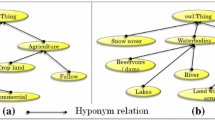Abstract
Analysis of geographic data that uses a nominal measurement framework is problematic since it limits the possible analytic methods that can be applied. Land cover change analysis is an example of this where both the actual change analysis as well as classification changes over time can be problematic. This study illustrates the use of semantic similarity metrics on parameterized category definitions, and how these metrics can be used to assess land cover change over time as a degree of perceived change with respect to the original landscape state. It also illustrates how changes of the categories, the classification system, over time can be analyzed using semantic similarity measures.
Preview
Unable to display preview. Download preview PDF.
Similar content being viewed by others
References
Ahlqvist, O.: A parameterized representation of uncertain conceptual spaces. Transactions in GIS 8(4), 493–514 (2004)
Ahlqvist, O.: Using uncertain conceptual spaces to translate between land cover categories. International journal of geographical information science 19(7), 831–857 (2005)
Ahlqvist, O., Gahegan, M.: Photogrammetric Engineering and Remote Sensing. Probing the relationship between classification error and class similarity (in press)
Ahlqvist, O., Keukelaar, J., Oukbir, K.: Rough and fuzzy geographical data integration. International journal of geographic information science 17(3), 223–234 (2003)
Bishr, Y.: Overcoming the semantic and other barriers to GIS interoperability. International Journal of Geographic Information Science 12(4), 299–314 (1998)
Bouchon-Meunier, B., Rifqi, M., Bothorel, S.: Towards general measures of comparison of objects. Fuzzy Sets and Systems 84, 143–153 (1996)
Comber, A., Fisher, P., Wadsworth, R.: Assessment of a semantic statistical approach to detecting land cover change using inconsistent data sets. Photogrammetric Engineering and Remote Sensing 70, 931–938 (2004)
Di Gregorio, A., Jansen, L.J.M.: Land Cover Classification System: Classification Concepts And User Manual. FAO, Rome (1998)
Dubois, D., Prade, H.: Rough fuzzy sets and fuzzy rough sets. Int. J. General Systems 17, 191–209 (1990)
Fonseca, F.T., Egenhofer, M.J., Agouris, P., Câmara, G.: Using ontologies for integrated geographic information systems. Transactions in GIS 6(3), 231–257 (2002)
Gärdenfors, P.: Conceptual spaces: the geometry of thought, 307 pp. MIT Press, Cambridge (2000)
Hahn, U., Chater, N.: Concepts and Similarity. In: Lamberts, K., Shanks, D. (eds.) Knowledge, Concepts and Categories, pp. 43–92. Psychology Press, East Sussex (1997)
Jones, C.B., Alani, H., Tudhope, D.: Geographical Terminology Servers – Closing the Semantic Divide. In: Duckham, et al. (eds.) Foundations of geographic information science, vol. 257, pp. 205–222. Taylor & Francis, London (2003)
Kaufman, A., Gupta, M.M.: Introduction to fuzzy arithmetic, 351 pp. Van Nostrand Reinhold Company, New York (1985)
Livingstone, D., Raper, J.: Modelling environmental systems with GIS: theoretical barriers to progress. In: Worboys, M.F. (ed.) Innovations in GIS 1, pp. 229–240. Taylor & Francis, London (1994)
Mennis, J.L.: Derivation and implementation of a semantic GIS data model informed by principles of cognition. Computers, Environment and Urban Sytems 27, 455–479 (2003)
Nosofsky, R.M.: Attention, similarity,and the identification-categorization relationship. Journal of Experimental Psychology: General 115, 39–57 (1986)
Nyerges, T.L.: Geographic information abstractions: conceptual clarity for geographical modeling. Environment and Planning A 23, 1483–1499 (1991)
Openshaw, S.: Commentary: Fuzzy logic as a new scientific paradigm for doing geography. Environment and Planning A 28, 761–768 (1999)
Power, et al.: Describe a hierarchical fuzzy pattern matching based on ad hoc rules for combinations of crisp landcover classes (2001)
Rodríguez, M.A., Egenhofer, M.J.: Comparing geospatial entity classes: an asymmetric and context-dependent similarity measure. International Journal of Geographical Information Science 18, 229–256 (2004)
Saaty, T.L.: The analytic hierarchy process: planning, priority setting, resource allocation. RWS Publications, Pittsburgh (1990)
Tversky, A.: Features of similarity. Psychological review 84, 327–352 (1977)
Usery, E.L.: A conceptual framework and fuzzy set implementation for geographic features. In: Burrough, P.A., Frank, A.U. (eds.) Geographic, Objects, With Indeterminate Boundaries, vol. 345, pp. 71–85. Taylor & Francis, London (1996)
Visser, U., Stuckenschmidt, H., Schuster, G., Vogele, T.: Ontologies for geographic information processing. Computers and Geosciences 28(1), 103–117 (2002)
Author information
Authors and Affiliations
Editor information
Editors and Affiliations
Rights and permissions
Copyright information
© 2005 Springer-Verlag Berlin Heidelberg
About this paper
Cite this paper
Ahlqvist, O. (2005). Using Semantic Similarity Metrics to Uncover Category and Land Cover Change. In: Rodríguez, M.A., Cruz, I., Levashkin, S., Egenhofer, M.J. (eds) GeoSpatial Semantics. GeoS 2005. Lecture Notes in Computer Science, vol 3799. Springer, Berlin, Heidelberg. https://doi.org/10.1007/11586180_8
Download citation
DOI: https://doi.org/10.1007/11586180_8
Publisher Name: Springer, Berlin, Heidelberg
Print ISBN: 978-3-540-30288-9
Online ISBN: 978-3-540-32283-2
eBook Packages: Computer ScienceComputer Science (R0)




